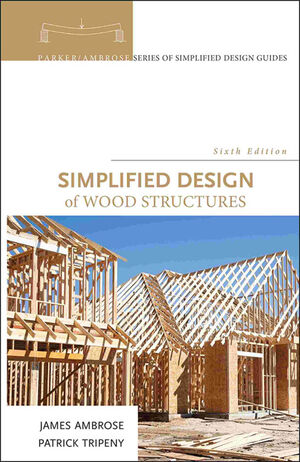Simplified Design of Wood Structures, 6th EditionISBN: 978-0-470-18784-5
Hardcover
416 pages
March 2009
 |
||||||
Preface to the First Edition.
Introduction.
1. Structural Uses of Wood.
1.1 Sources of Wood.
1.2 Tree Growth.
1.3 Density of Wood.
1.4 Defects in Lumber.
1.5 Seasoning of Wood.
1.6 Nominal and Dressed Sizes.
1.7 Use Classification of Structural Lumber.
1.8 Grading of Structural Lumber.
1.9 Fabricated Wood Products.
2. Design Issues and Methods.
2.1 Design Goals.
2.2 Methods of Investigation and Design.
2.3 Choice of Design Method.
3. Structural Investigation.
3.1 General Concerns.
3.2 Forces and Loads.
3.3 Direct Stress.
3.4 Kinds of Stress.
3.5 Deformation.
3.6 Elastic Response and Limit.
3.7 Inelastic Behavior and Ultimate Strength.
3.8 Modulus of Elasticity.
3.9 Permissible Values for Design.
4. Design Data and Criteria.
4.1 General Concerns.
4.2 Reference Design Values for Allowable Stress Design (ASD).
4.3 Adjustment of Design Values.
4.3 Modification for Loading with Relation to Grain Direction.
4.4 Design Controls for LRFD.
5. Beam Functions.
5.1 General Considerations.
5.2 Moments.
5.3 Beams Loads and Reaction Forces.
5.4 Beam Shear.
5.5 Bending Moment.
5.6 Tabulated Values for Beam Behavior.
5.7 Multiple Span Beams.
6. Behavior of Beams.
6.1 Shear in Beams.
6.2 Bending in Beams.
6.3 Deflection.
6.4 Bearing.
6.5 Buckling of Beams.
6.6 Unsymmetrical Bending.
6.7 Behavior Considerations for LRFD.
7. Design of Beams.
7.1 Design Procedure.
7.2 Beam Design Examples.
7.3 Joists and Rafters.
7.4 Alternative Spanning Elements.
8. Wood Decks.
8.1 Board Decks.
8.2 Plank Decks.
8.3 Wood Fiber Decks.
8.4 Plywood Decks.
8.5 Spanning Capability of Decks.
9. Wood Columns.
9.1 Slenderness Ratio for Columns.
9.2 Compression Capacity of Simple Solid Columns.
9.3 Column Load Capacity, LRFD.
9.4 Round Columns.
9.5 Stud Wall Construction.
9.6 Spaced Columns.
9.7 Built-up Columns.
9.8 Columns with Bending.
10. Connections for Wood Structures.
10.1 Bolted Joints.
10.2 Nailed Joints.
10.3 Screws.
10.4 Mechanically-Driven Fasteners.
10.5 Shear Developers.
10.6 Split-Ring Connectors.
10.7 Formed Steel Framing Elements.
10.8 Concrete and Masonry Anchors.
10.9 Plywood Gussets.
11. Trusses.
11.1 General Considerations.
11.2 Types of Trusses.
11.3 Bracing for Trusses.
11.4 Loads on Trusses.
11.5 Investigation for Internal Forces in Planar Trusses.
11.6 Design Forces for Truss Members.
11.7 Combined Actions in Truss Members.
11.8 Truss Members and Joints.
11.9 Timber Trusses.
11.10 Manufactured Trusses.
12. Miscellaneous Wood Products and Elements.
12.1 Engineered Wood Products.
12.2 Glued Laminated Structural Members.
12.3 Structural Composite Lumber.
12.4 Wood Structural Panels.
12.5 Plywood.
12.6 Prefabricated Wood I-Joists.
12.7 Built-Up Panel and Lumber Beams.
12.8 Flitched Beams.
12.9 Pole Structures.
13. Wood Structures for Lateral Bracing.
13.1 Application of Wind and Earthquake Effects.
13.2 Horizontal Diaphragms.
13.3 Vertical Diaphragms (Shear Walls).
13.4 Investigation and Design of Wood-Framed Shear Walls.
13.5 Trussed Bracing for Wood Frames.
13.6 Special Lateral Bracing.
14. General Considerations for Building Structures.
14.1 Choice of Building Construction.
14.2 Structural Design Standards.
14.3 Loads for Structural Design.
14.4 Dead Loads.
14.5 Building Code Requirements.
14.6 Live Loads.
14.7 Lateral Loads (Wind and Earthquake).
14.8 Load Combinations and Factors.
14.9 Determination of Design Loads.
14.10 Structural Planning.
14.11 Building System Integration.
14.12 Economics.
15. Building Design Examples.
15.1 Building One: Single Story Light Wood Frame.
15.2 Building Two: Multistory Light Wood Frame.
15.3 Building Three: Masonry and Timber Structure.
15.4 Building Four: Steel and Wood Structure.
Appendix A: Properties of Sections.
Appendix B: Study Aids.
Appendix C: Answers to Problems.
Glossary.
References.
Index.



